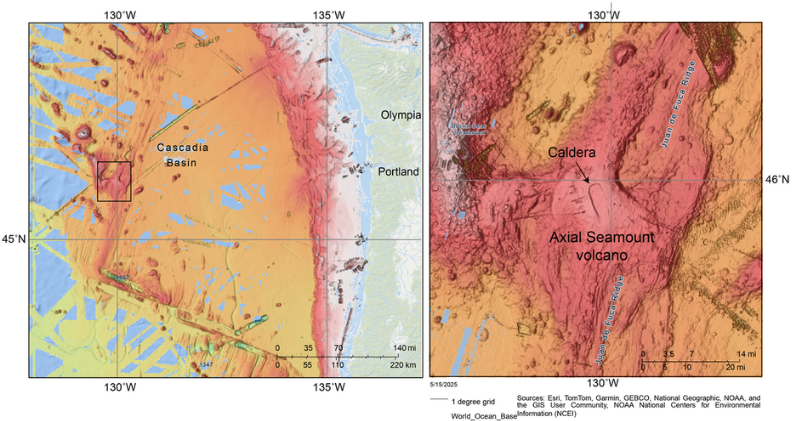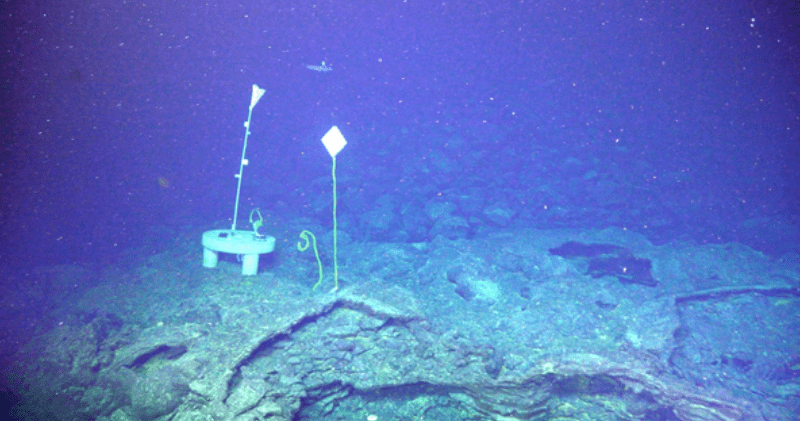May 23, 2025
What Happens When Underwater Volcanoes Erupt?
BY: Anna Ricci
If a volcano erupts underwater and no one is around to see it, does it actually happen? Turns out, 80% of volcanic activity occurs in the sea, but it often receives less attention than its aboveground counterparts. Fortunately, one underwater volcano is bringing the discussion to light.
Hundreds of miles off the coast of Oregon, the Axial Seamount volcano could erupt this year.

As part of an underwater geological hot spot known as the Juan de Fuca Ridge, the volcano sits between two spreading tectonic plates. When the plates move, pressure builds up beneath the Earth’s surface, generating earthquakes that trigger eruptions. In April 2015, the last time the Axial Seamount erupted, scientists detected around 8,000 of these earthquakes in only 24 hours.
BUT WHAT REALLY HAPPENS WHEN UNDERWATER VOLCANOES ERUPT?
Like the Axial Seamount volcano, most underwater volcano eruptions are caused by tectonic plate movement prompting an earthquake on the seafloor. These eruptions can last anywhere from a couple of minutes to several hours and contain a combination of lava and gas.
These underwater volcanoes differ greatly from those above ground. Volcanoes on land are highly explosive and produce ash and lava that can damage landscapes. Underwater volcanoes, on the other hand, are typically less explosive due to high water pressure, with magma that cools quickly thanks to surrounding water.

As the lava cools, it solidifies over time to form new or build on existing mounds or seamounts. While these seamounts can be formed by eruptions from existing volcanoes, some are also old volcanoes themselves, which scientists have deemed “extinct,” meaning they’re unlikely to erupt again.
HOW DOES THIS AFFECT THE SURROUNDING ECOSYSTEM?
When underwater volcanoes erupt, they don’t just shape the seafloor – they help shape life in the ocean. When they erupt, they can release toxic gases and heat that can impact marine life. But over time, they also create new habitats and provide resources for many species, fostering some of the most unique ecosystems on the planet.
For example, underwater volcanic activity causes small cracks, called hydrothermal vents, to form along the seafloor. These vents release hot, mineral-rich water that is both physically and chemically different from typical sea water. Tiny bacteria around the volcano can use these chemicals to make energy, creating a food source that supports all kinds of ocean life. In fact, several hydrothermal vents have been the site of new species discoveries.
In addition to these vents, seamounts attract whales, sharks, and fish. Even deep-sea creatures like black oreo and black cardinalfish can be found in these areas.
These biodiversity hotspots are so full of life that some scientists believe they have the necessary qualities that origin of life on Earth would have required. It’s surprising underwater volcanoes aren’t a larger topic of discussion seeing as they play such a critical role in ecosystem health!
LEARN MORE
Whether we see them or not, underwater volcanoes quite literally shape the planet. Contributing to a lush underwater ecosystem with their nutrient-dense eruptions, these biodiversity hotspots allow species to flourish several thousand feet below sea level.
To learn more about what’s going on in our oceans, become an Oceana Wavemaker today.



